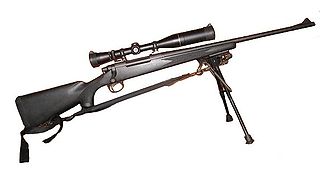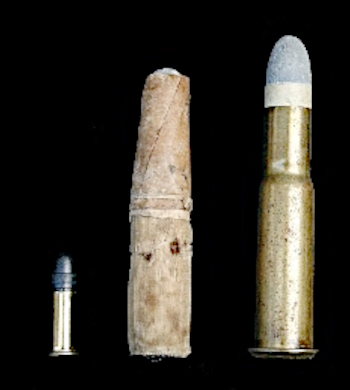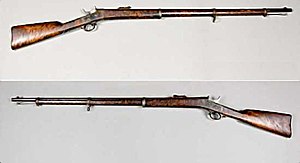
The 3-line rifle M1891, colloquially known in the West as Mosin–Nagant and in Russia as Mosin's rifle, is a five-shot, bolt-action, internal magazine–fed, military rifle developed from 1882 to 1891, and used by the armed forces of the Russian Empire, the Soviet Union and various other nations. It is one of the most mass-produced military bolt-action rifles in history with over 37 million units having been made since its inception in 1891, and, in spite of its age, it has been used in various conflicts around the world up to the present day. It is primarily found chambered for its original 7.62×54mmR cartridge.
The FAL is a battle rifle designed by Belgian small arms designer Dieudonné Saive and manufactured by FN Herstal.

Mauser, originally Königliche Waffen Schmieden, is a German arms manufacturer. Their line of bolt-action rifles and semi-automatic pistols has been produced since the 1870s for the German armed forces. In the late 19th and early 20th centuries, Mauser designs were also exported and licensed to many countries which adopted them as military and civilian sporting firearms. The Mauser Model 98 in particular was widely adopted and copied, and is the foundation of many of today's sporting bolt action rifles.
A semi-automatic firearm, also called self-loading firearm or autoloading firearm, is one that not only fires a bullet each time the trigger is pulled but also performs all steps necessary to prepare it to discharge again—assuming cartridges remain in the firearm's feed device. Typically, this includes extracting and ejecting the spent cartridge case from the firing chamber, re-cocking the firing mechanism, and loading a new cartridge into the firing chamber. To fire again, the trigger is released and re-pressed.

The M1903 Springfield, formally the United States Rifle, Caliber .30-06, Model 1903, is an American five-round magazine fed, bolt-action service repeating rifle, used primarily during the first half of the 20th century.
Remington Arms Company, LLC is an American manufacturer of firearms and ammunition. It was founded in 1816 by Eliphalet Remington in Ilion, New York, as E. Remington and Sons. Remington is America's oldest gun maker and is claimed to be America's oldest factory that still makes its original product. Remington is the largest U.S. producer of shotguns and rifles. The company has developed or adopted more cartridges than any other gun maker or ammunition manufacturer in the world.

During World War I, the United States secretly developed the Pedersen device attachment for the M1903 Springfield rifle that allowed it to fire a .30 caliber (7.62 mm) pistol type cartridge in semi-automatic mode. This attachment was developed to allow an infantryman to convert "his rifle to a form of submachine gun or automatic rifle" in approximately 15 seconds.

The .223 Remington is a rifle cartridge, developed in 1957, for the ArmaLite AR-15. In 1964, the ArmaLite AR-15 was adopted by the United States Army as the M16 rifle, and it would later become the standard U.S. military rifle. The military version of the cartridge uses a 55-gr full metal jacket bullet and was designated M193. In 1980, the .223 Remington was transformed into a new cartridge, a 62-gr full metal jacket bullet with a 7-gr steel core for better penetration and designated 5.56×45mm NATO.
The Krag–Petersson was the first repeating rifle adopted by the armed forces of Norway and was one of the first repeating rifles to be adopted as standard issue by a military force, being preceded by the Swiss Vetterli adopted in 1867. Developed by Ole Herman Johannes Krag, the action of the Krag–Petersson was uniquely actuated by an oversized hammer. Another distinguishing feature was that the cartridge rising from the magazine was not seated automatically, but had to be pushed into the breech of the rifle.
The Fabrique Nationale Model 1949 is a rifle available as both a semi-automatic rifle and as a selective fire automatic rifle designed by Dieudonné Saive and manufactured by Fabrique Nationale. It was used by the militaries of Argentina, Belgium, the Belgian Congo, Brazil, Colombia, Egypt, Indonesia, Luxembourg, and Venezuela. The automatic rifle version with selective fire produced for Belgium was known as the AFN.

The Remington Model 700 is a series of bolt-action centerfire rifles manufactured by Remington Arms since 1962. It is a development of the Remington 721 and 722 series of rifles, which were introduced in 1948. The M24 and M40 military sniper rifles, used by the US Army and USMC, respectively, are both based on the Model 700 design.

The Model 1867 Remington rolling block rifle was the first rifle using metallic cartridges to be adopted by the Swedish and Norwegian armies. Nominally it had a caliber of 4 decimal lines, but the actual caliber was 4.1 Swedish decimal lines or 3.88 Norwegian decimal lines (12.17 mm), and it fired a rimfire round with a 12.615 mm lead bullet. The 12.17 mm caliber was chosen because the Swedish army had approximately 30,000 new muzzle-loading Model 1860 and breech-loading Model 1864 rifles in 12.17 mm caliber in stock, rifles that were suitable for conversion to Model 1867 rolling block rifles. With the exception of the first 10,000 rifles and 20,000 actions, which were made by Remington in the US, all Model 1867 Remington rolling block rifles and carbines were made under license in Sweden and Norway, by Carl Gustafs stads Gevärsfaktori and Husqvarna Vapenfabriks Aktiebolag in Sweden and by Kongsberg Vaapenfabrik in Norway, with the two Swedish manufacturers producing about 80% of the weapons.

The M1917 Enfield, the "American Enfield", formally named "United States Rifle, cal .30, Model of 1917" is an American modification and production of the .303-inch Pattern 1914 Enfield (P14) rifle developed and manufactured during the period 1917–1918. Numerically, it was the main rifle used by the American Expeditionary Forces in Europe during World War I. The Danish Sirius Dog Sled Patrol on Greenland still use the M1917, which performs reliably in Arctic conditions, as their service weapon.

The Rifle, .303 Pattern 1914 was a British service rifle of the First World War period. A bolt action weapon with an integral 5-round magazine, it was principally contract manufactured by companies in the United States. It served as a sniper rifle and as second line and reserve issue until being declared obsolete in 1947. The Pattern 1914 Enfield was the successor to the Pattern 1913 Enfield experimental rifle and the predecessor of the U.S. Rifle M1917 Enfield.

The Remington Rolling Block rifle is a breech-loading rifle that was produced from the mid-1860s into the early 20th century by E. Remington and Sons. The action was extremely strong, and could easily withstand the increased pressure of the new smokeless powders coming into use by the late 1880s.

An intermediate cartridge is a rifle/carbine cartridge that is shorter than typical full-power battle rifle cartridges, but still has greater length than pistol/personal defense weapon cartridges. As their recoil is significantly reduced compared to full-power rifle cartridges, fully automatic rifles firing intermediate cartridges are relatively easy to control. However, even though less powerful than a traditional full-power rifle cartridge, the ballistics are still sufficient for an effective range of 300–600 metres (330–660 yd), which are the maximum typical engagement ranges in modern combat. This allowed for the development of the assault rifle, a selective fire weapon that is more compact and lighter than rifles that fire full-power rifle cartridges.

The M2010 Enhanced Sniper Rifle (ESR), formerly known as the XM2010 and M24 Reconfigured Sniper Weapon System, is a sniper rifle developed by PEO Soldier for the United States Army. It is derived from the M24 Sniper Weapon System and replaced the existing M24s. After winning a competitive bidding process, Remington was awarded the production contract for up to 3,600 weapons. The Army had anticipated sending the upgraded weapons to deployed snipers in late 2010, but later expected fielding would happen in January 2011.

The 7.92×33mm Kurz is a rimless bottlenecked intermediate rifle cartridge developed in Nazi Germany prior to and during World War II. The ammunition is also referred to as 7.9mm Kurz, 7.9 Kurz, 7.9mmK, or 8×33 Polte. It was specifically intended for development of the Sturmgewehr 44. The round was developed as a compromise between the longer 7.92×57mm rifle and the 9×19mm Parabellum pistol rounds, and is known as an intermediate cartridge.
The .43 Spanish was a centerfire firearms cartridge. The .43 Spanish was adopted about 1867, and was used in early rolling block rifles that Remington manufactured for the government of Spain. The cartridge is also referred to as "11mm Spanish", and identical cartridges for the US Peabody rifle were marked "U.M.C. 43-77".

The 11×59mmR Gras, also known as the 11mm Vickers, is an obsolete rifle cartridge. France's first modern military cartridge, the 11×59mmR Gras was introduced in 1874 and continued in service in various roles and with various users until after World War II.













